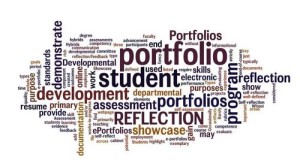Hello everyone! Welcome to the first week of CUPID Blogging!
To start, we’re going to discuss portfolio building, and some tips that I have gathered over the years from experience (and relentlessly questioning other PWR majors). Regardless of your year and level of experience, portfolio building is a crucial skill to develop as a budding professional, and particularly as a Professional Writing and Rhetoric major. From someone who has just completed the draft of her senior portfolio (seniors, take a breath!), there are many things I wish I had done/known a few years before. Here is a list that I’ve compiled that can helpfully hope you if you’ve got more time, or make you laugh if you’ve just turned it in…
- After you complete a project, whether for class, an internship, a job, etc,. jot down a few notes about what you did, how the experience went and what you learned from it! Write it all down! It’s much easier to remember what all happened after a couple weeks- not two years later! Composing miniature contextual narratives, just for yourself, will come in handy when you’ve picked your best documents but can’t remember what all of your rhetorical decisions were.
- When designing your resume, create a master copy, and then adapt a version for each context. To keep track, always make copies and date them! There’s nothing worse than having a great design for a resume and not being able to find it a few months later.
- Once you start creating your portfolio, save the designing for the end! As much fun as it is to pick colors and create banners, your content should be the primary focus. Typically, your design will change once the content is chosen and placed!

- Organizing your portfolio can be tricky. Pick your documents first! Don’t try to fit your documents into sections; those should be created based upon which projects are best to showcase for your portfolio and your professional identity.
- Whether altering a document or a segment of code, always save a copy!!
Congrats Seniors! Your portfolios are completed (or at least drafted)! First-Years, Sophomores and Juniors, you’ve got this! (Also, go get your picture professionally taken; it helps to have that one picture you can use for all professional documentation and social media)


 Follow
Follow
2 Comments
I found the third point that Alexa made in which she encouraged us to focus on the content above the design really interesting. In the creation of my PWR Portfolio, I focused heavily on updating and editing my content; however, I found myself mindlessly clicking in the right corner on “Settings” as a means of distracting myself from the actual content quite frequently. It can be a lot more enjoyable to make something visually appealing before making the thing a work that is even valuable enough to display nicely. Plus, design is always fun. However, I do see the benefit of allowing yourself enough time when crafting a portfolio to work on the design to a certain extent before focusing on the content. For me personally, I know that I am a lot happier looking at a page that is visually appealing than one that is blank or not altered from the template version. I also see the value in personalizing the design as a means of putting yourself in the mindset to create a portfolio full of content that reflects you personally as well. The point that Alexa made that the design will probably change with the alteration of content was spot on. I found myself making my design a bit more relaxed and less typically “professional” when I realized the type of content that I was including. However, I can’t say that I was disappointed I had put some time in initially to begin finding the design and the branding that worked for me. I (hopefully) found a way to maintain a professional portfolio without confining my creativity.
I really like these tips. I’ve made several (far from perfect) portfolios in the past few years and these issues always come up. I think tip one, keeping notes on projects immediately after you finish them, is especially relevant in my portfolio building experience. I have had several internships and large projects but have a tendency to file them away deep in Google Drive and forget about their relevance to my career. As I start compiling specific portfolios I realize how beneficial it would be to start from the beginning rather than scrambling to work backwards.
Thanks for the tips!